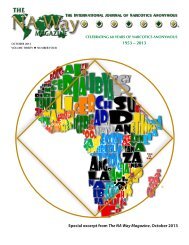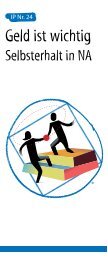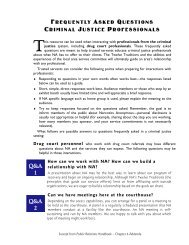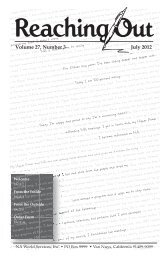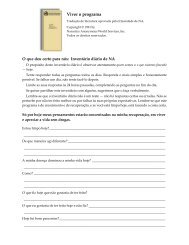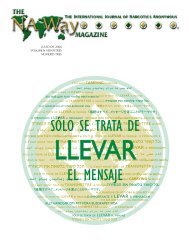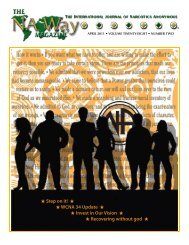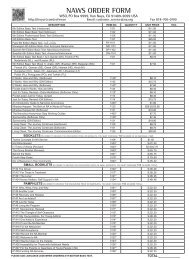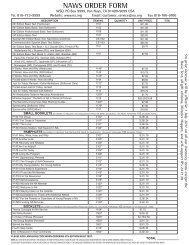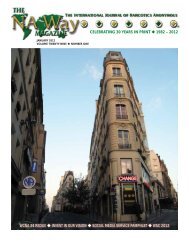Public Relations Handbook - Narcotics Anonymous
Public Relations Handbook - Narcotics Anonymous
Public Relations Handbook - Narcotics Anonymous
Create successful ePaper yourself
Turn your PDF publications into a flip-book with our unique Google optimized e-Paper software.
Anonymity is not in conflict with making the NA message more available andunderstood in our communities. Speaking about NA to a correctional facility toprovide H&I information, or presenting the program of NA to a secondary school toinform an audience about recovery, are positive efforts of our service committees—actions that demonstrate NA’s message of recovery. These examples do not involvethe public media, where maintaining personal anonymity is always encouraged.There may be times when nonaddicts can help us protect our anonymity asrecovering addicts in the public media. Those outside of NA often have the ability toenter media venues in a manner that can help further our primary purpose. Forexample, a judge may talk about their positive experience with NA, describing howhundreds of addicts have changed their lives because they started to attend NAmeetings, and speaking about the effectiveness of our program of recovery. We arenot asking nonaddicts to carry NA’s message,“Anonymity is notin conflict with making theNA message moreavailable and understoodin our communities.”we are asking them to speak about our messageof recovery. The role of nonmembers is tosimply carry information about NA.A nonaddict professional helps members toretain their personal anonymity with the pressand protects any individual NA member frombeing considered a spokesperson for <strong>Narcotics</strong><strong>Anonymous</strong>. We don’t risk our program’scredibility as much, since a nonaddict is completely separate from our membership.Members can also maintain the focus of carrying NA’s message instead of becomingoverwhelmed with representing NA in the media. Nonaddict professionals, likejudges, are often inclined to discuss their experiences with our program. It is ourresponsibility to make sure that these members of the public are well-informed andthat they have had a positive experience with NA.If an area service committee has decided to use a nonaddict in a public mediaevent, the area needs to responsibly address any possible challenges. One importantconcern is that an outside nonmember could possibly become associated as “theface of NA.” One way a local service body can ensure that they have beenresponsible in this type of situation is to make certain that they have clearly definedthe nonmember’s role in and relationship to NA. Being responsible helps theserelationships to be successful.Each public event and opportunity is unique. The local service body is usually bestequipped to make informed decisions about the appropriate use of nonaddicts.Evaluating the nature of the event and the relationship with the nonaddicts involvedcan help an area decide if including a nonaddict is appropriate for each situation.The traditions describe a fellowship that takes collective guidancefrom spiritual principles rather than individual personalities. That kindof selflessness is what the Twelfth Tradition means by the word“anonymity.”It Works: How and WhyAnonymity and equalityAnonymity gives every addict who attends NA meetings an equal chance at findingrecovery. When members live by principles, it doesn’t matter how addicts look,where addicts came from, how educated or uneducated they may be, or how muchmoney they have or don’t have. If an attractive newcomer begins attending a meeting8 | Chapter 2 | Core PR Principles



